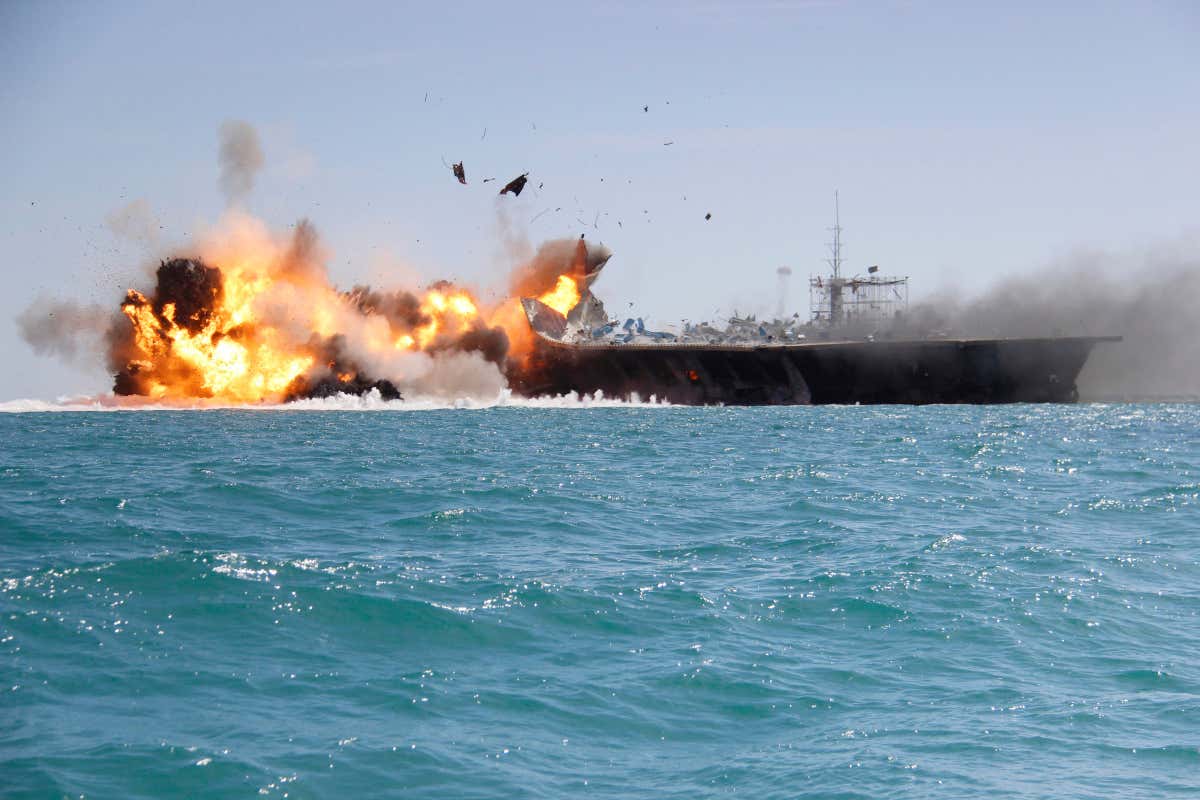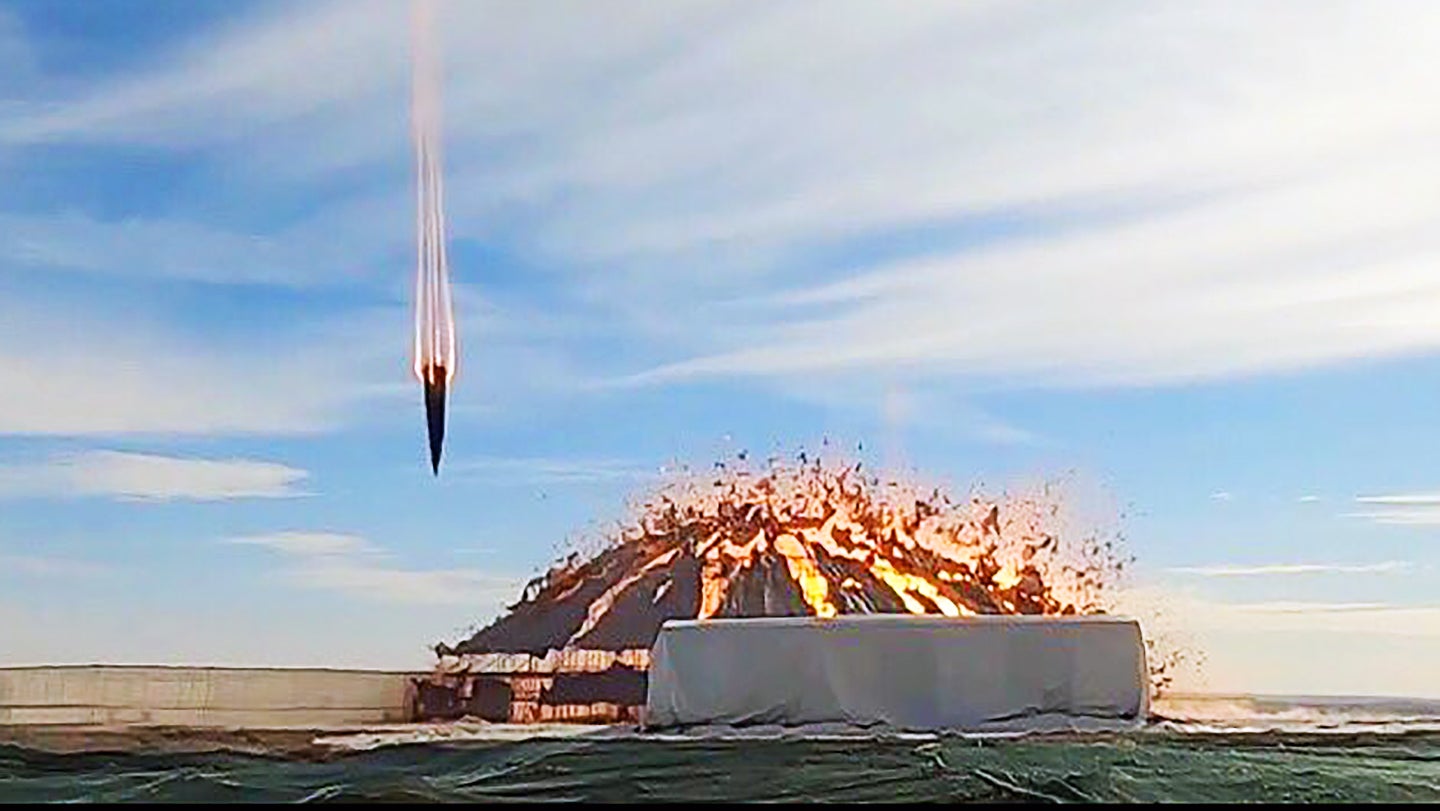Dramatic video has emerged from Iranian state television showing recent tests of ballistic missiles and other weapons aimed against targets that include a rough mockup of Israel’s nuclear facility near Dimona in the Negev Desert. In one remarkable sequence, the warhead of what appears to be a Dezful medium-range ballistic missile (MRBM) leaves an impressively fiery trail behind it immediately before it impacts the target.
The footage comes from a five-day exercise known as Great Prophet 17, carried out in southern Iran, which came to an end last Friday. The war games were intended as an explicit warning to Israel in light of Tehran’s worries over possible Israeli plans to target Iran’s own nuclear sites. With that in mind, Iran’s Islamic Revolutionary Guard Corps (IRGC) carried out the attack on the mockup of Dimona nuclear complex, home to a secretive Israeli nuclear reactor, while official video combined this with a digital mock-up showing an aerial view of the Israeli site.
“Through a simulation of the Dimona atomic facilities, the Revolutionary Guards successfully practiced attacking this critical center of the Zionist regime in its missile exercise,” the semi-official Tasnim news agency stated. Exactly how realistic that mockup of Dimona was is questionable, with a clear physical resemblance to the nuclear reactor but apparently little in the way of a substantial structure.
According to Iran’s Chief of Staff of the Armed Forces, Maj. Gen. Mohammad Bagheri, the culmination of the maneuvers included the simultaneous launch of 16 ballistic missiles as well as 10 Shahed-136 loitering munitions, or ‘suicide drones,’ which are also shown being deployed from previously unseen box-like launchers, each containing five drones and mounted on a truck.
Iranian-backed Houthi forces operating in Yemen have previously used unmanned aerial vehicles (UAVs) of a similar type. With long-endurance capabilities, these weapons would potentially be able to reach Israel, but they could be launched in Syria or even Lebanon for a far less lengthy trip.
“We will cut off their hands if they make a wrong move,” warned Maj. Gen. Hossein Salami, the commander-in-chief of the IRGC. “The difference between actual operations and military exercises is only a change in the angles of launching the missiles.”
In the accompanying video, the rear portion of one of the missiles aimed at the Dimona mockup can be seen leaving a bright orange trail behind it, an instant before it impacts the target, which has already been shook by the detonation of the warhead from a previous missile.
Observers have offered a range of explanations for what this fiery phenomenon might be, with some suggesting it could be a plasma sheath. This is an effect that’s been noted with other very-high-speed projectiles in the Earth’s atmosphere. It’s especially prevalent when a fairly blunt projectile is moving with a very high velocity, creating an enormous shockwave that in turn heats the air around it, resulting in a telltale plasma build-up.
It has also been suggested that the effect might be the result of water condensing around the fast-moving warhead. Other open-source intelligence observers have suggested that what we are seeing is the combustion of the composite materials used in the guidance fins at the rear of the Dezful MRBM due to the high temperatures encountered during its terminal attack phase.
There is also a curious point around the five-second mark in the video embedded in the tweet below when the fiery missile becomes distorted. Some observers have attributed this to the detonation of the previous missile, and the resulting blast wave, but others suggest the same shockwave led to a simple glitch in the digital recording.
As for the Dezful, most sources agree that this is the missile used in the mock attack on the Israeli nuclear facility. A derivative of the Zulfiqar short-range ballistic missile, the Dezful similarly features a single-stage solid-propellant motor whose range has been extended to around 620 miles. The missile was unveiled in February 2019, during celebrations marking the 40th anniversary of the Islamic Republic, when examples were displayed in an underground missile facility. The Iranian ballistic missile threat, in general, has come to greater prominence since then, above all due to the unprecedented ballistic missile strikes against Al Asad Air Base in Iraq, which involved Qiam-1 short-range ballistic missiles (SRBMs) hitting the base with impressive accuracy.
Meanwhile, Iran using its military to make threats against Israel is nothing new, but it’s significant that these latest exercises pointed explicitly to Iran’s nuclear infrastructure as a target.
Also of interest is the fact that the IRGC has shown off apparent plans to use ballistic missiles in combination with drones to attack the Dimona facility. In the past, as during the attack on Saudi Arabian energy facilities in 2019, Iranian drones have been used together with cruise missiles to hit key infrastructure. The Houthis claimed responsibility for those attacks, but there is widespread agreement that they were orchestrated by Tehran. The ‘layering’ of high-end and lower-end capabilities of vastly different performance capabilities greatly complicates defending against a potential strike. Also, the weapon used can be better tailored for the target it is intended for.
On the other hand, there is a huge difference between blowing up an apparent cinder-block bunker structure on a range as part of a military exercise and an attack on a genuine Israeli facility far away that would also have to deal with that country’s highly advanced air defense network, which includes anti-ballistic missile capabilities that are expressly designed to fend off exactly this type of offensive. After all, Iran has on more than one occasion destroyed a mocked-up U.S. Navy aircraft carrier, in an event that was clearly tailored at least as much for propaganda value as it was a genuine reflection of military capabilities. With that in mind, it seems at least highly probable that the Dimona attack exercise was just as much of a symbolic act as one used for training and testing.

As for the standoff between Iran and Israel, that shows no signs of abating. Israel continues to oppose efforts to resurrect the 2015 nuclear deal with Tehran — more formally known as the Joint Comprehensive Plan of Action (JCPOA). This deal had provided for a partial lifting of sanctions imposed on Iran in exchange for the country reducing its nuclear activities and opening up its facilities for enhanced inspections. Then-U.S. President Donald Trump abandoned the JCPOA in 2018. While the current administration under President Joe Biden has advocated a return to the terms of the 2015 deal, Israel doesn’t think the deal goes far enough. For example, the JCPOA does not put limits on Iran’s ballistic-missile development program.
Israeli officials have threatened military action against Iranian nuclear infrastructure if diplomacy fails. Talking to the BBC in November, an anonymous Israeli security official said: “In light of Iranian progress of their nuclear program, we are preparing for all options and scenarios, including military capabilities.”
Israel also has a track record of long-range attacks on the burgeoning nuclear infrastructure in countries it has deemed to be threatening, launching airstrikes on Iraq in 1981 and Syria in 2007. The stakes involved in a pre-emptive Israeli strike against Iran would be much higher, however, not least due to Tehran’s stated willingness to respond with its own ballistic missiles, drones, and other capabilities, including a network of proxies across the Middle East that it arms and supports. Iranian nuclear infrastructure — as well as ballistic missiles — is also increasingly hardened against attack, including expansive underground sites.
Israel, however, has other options at its disposal as it seeks to curtail the potential for Iranian nuclear weapons. In the past, Israel has been blamed for high-profile assassinations of key figures in the Iranian nuclear program, including Mohsen Fakhrizadeh, described as the “father of Iran’s nuclear bomb.” In November 2020, Fakhrizadeh was killed — reportedly by Israel’s top intelligence agency Mossad or individuals working on its behalf — in a complex attack on the car he was traveling in.
There have also been cyberattacks against Iranian nuclear infrastructure that appear to have originated in Israel and apparent kinetic attacks on Iranian facilities, including at Natanz in July last year. At the same time, Israel continues to conduct airstrikes against Iranian forces in Syria.
For its part, Tehran has long insisted that its nuclear program is civilian rather than military in nature. However, before a new round of nuclear talks began, Iran revealed it had achieved 60 percent purity for its enriched uranium, almost the level required to build a functioning nuclear weapon.
While negotiations around an Iranian nuclear deal continue in Vienna, it seems that Tehran’s latest war games — with their explicit threat toward Israel’s nuclear program — are intended as a highly visible reminder that its military, and especially its ever more capable ballistic missile and suicide drone forces, is prepared to respond in kind should Israel run out of patience and decide to strike Iran’s nuclear capabilities.
Contact the author: thomas@thedrive.com
